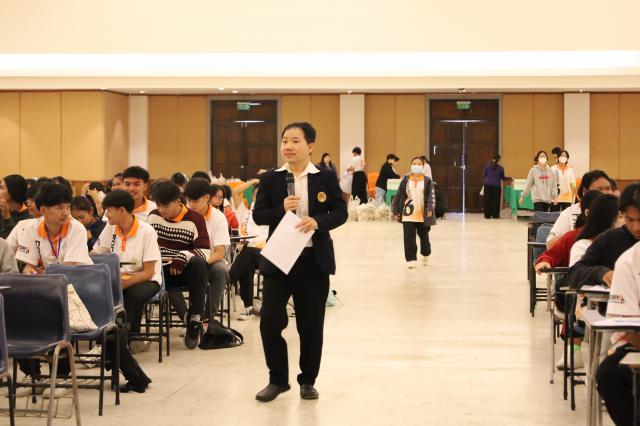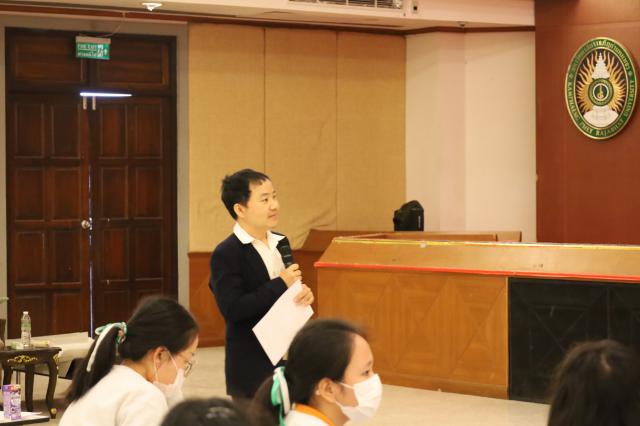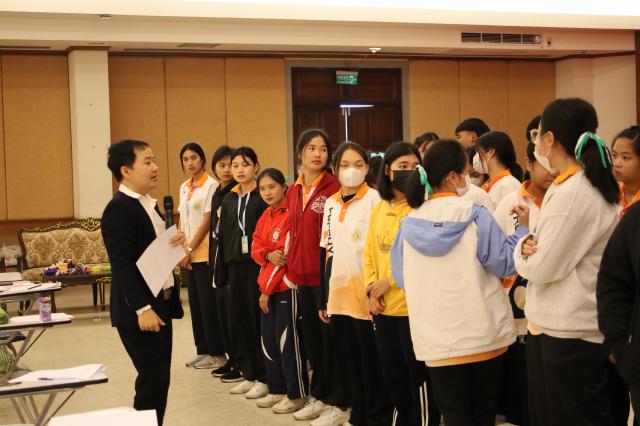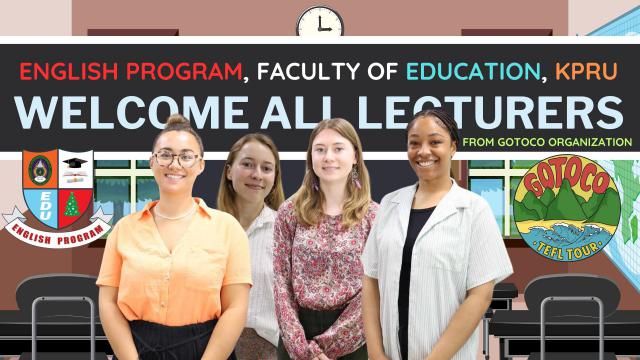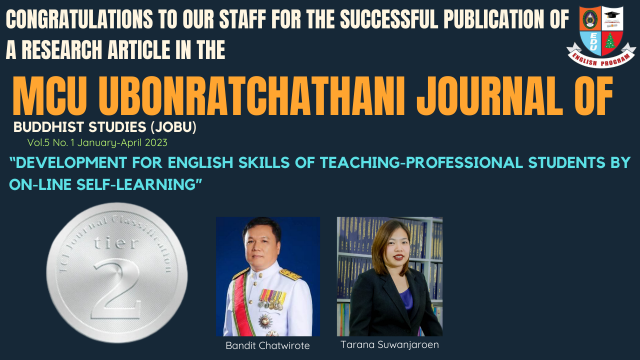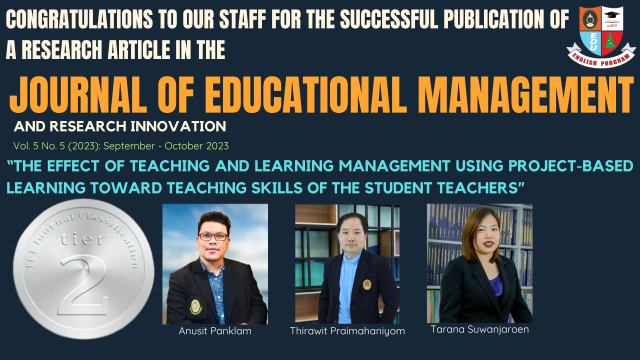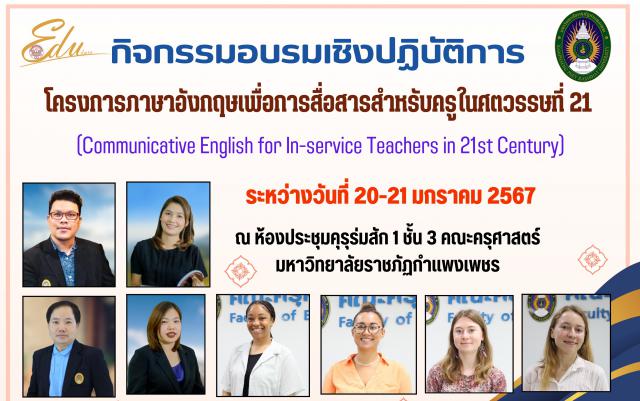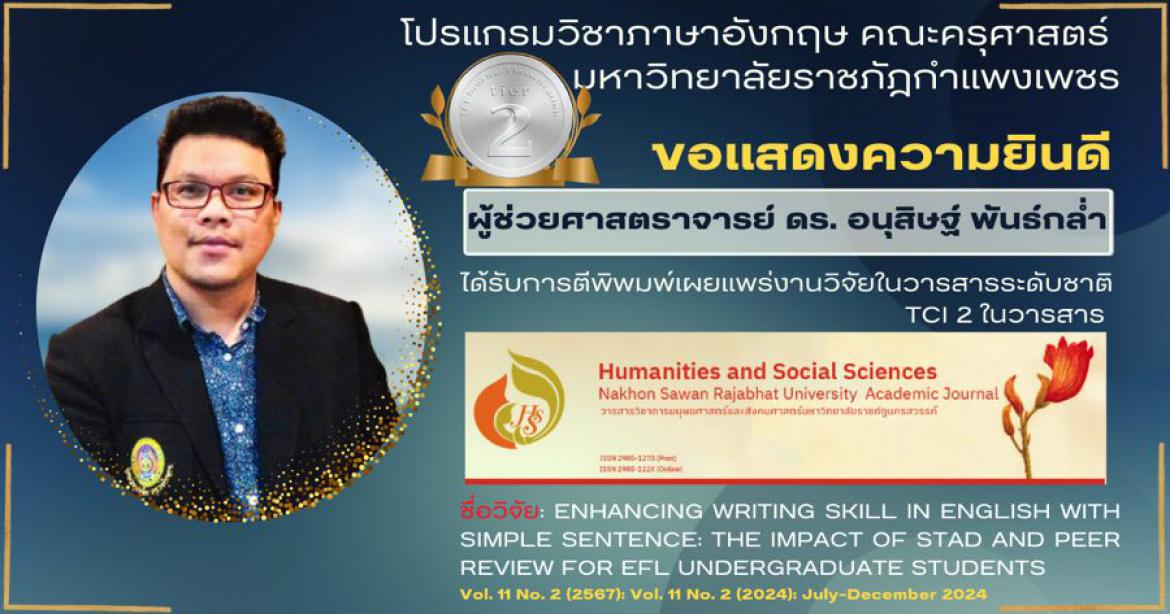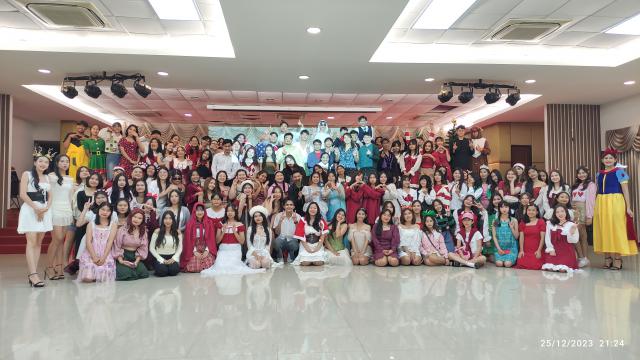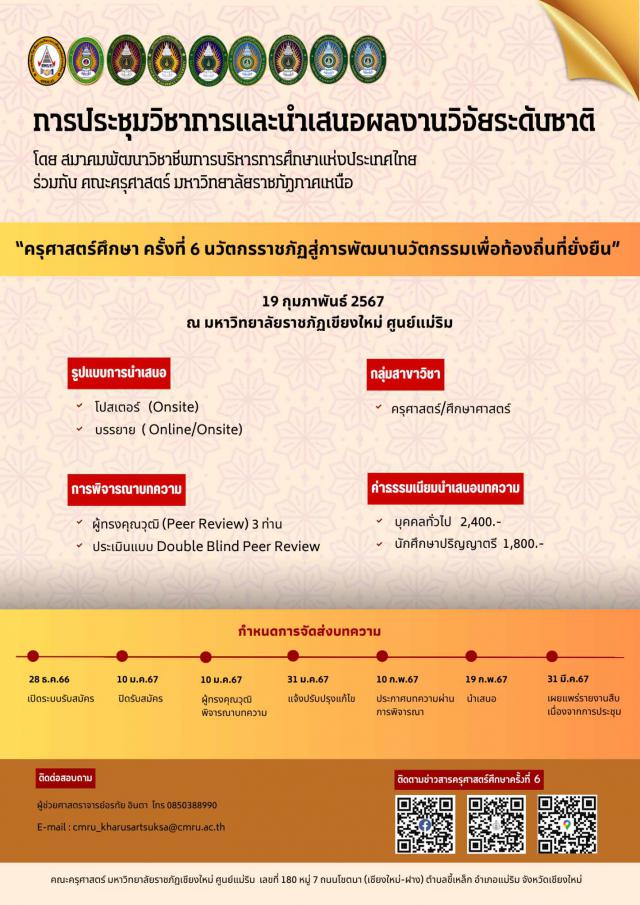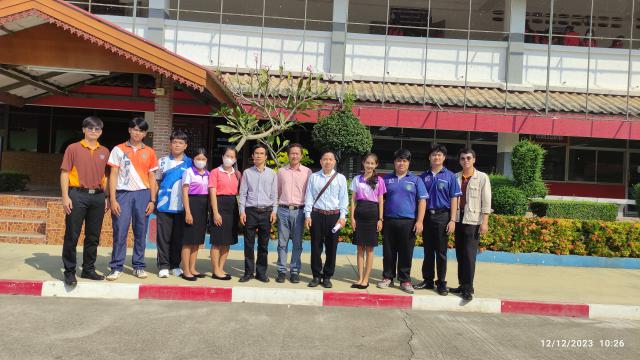ลำดับ 51. กิจกรรมพัฒนาคุณธรรมจริยธรรมสำหรับนักศึกษาชั้นปีที่ 1
เผยแพร่เมื่อ 21-01-2024 ผู้ชม 8,521,480,046 Share
วันที่ 21 มกราคม 2567 นักศึกษาโปรแกรมวิชาภาษาอังกฤษ ชั้นปีที่ 1 ได้เข้าร่วมกิจกรรมการพัฒนานักศึกษาครูรายชั้นปี เพื่อนักศึกษาครูชั้นปีที่ 1 โดยทีมวิทยากรอาจารย์คณะครุศาสตร์ ผศ.วชิระ พิมพ์ทอง อาจารย์ประจำโปรแกรมวิชาการประถมศึกษา , ดร.มนตรี หลินภู อาจารย์ประจำหลักสูตรจิตวิทยา และผศ.ดร.ถิรวิท ไพรมหานิยม อาจารย์ประจำโปรแกรมวิชาภาษาอังกฤษ
ลำดับ 52. ยินดีต้อนรับอาจารย์แลกเปลี่ยนจากประเทศอังกฤษ
เผยแพร่เมื่อ 20-01-2024 ผู้ชม 852,832 Share
โปรแกรมวิชาภาษาอังกฤษขอต้อนรับอาจารย์จากประเทศอังกฤษ รุ่นที่ 2 ในโครงการบันทึกความเข้าใจแลกเปลี่ยนอาจารย์กับ Gotoco จำนวน 4 ท่าน ได้แก่ 1.Louise Ayton 2.Jana Aizupe 3.Holly Brett และ 4.Valerie Achebe ระหว่างวันที่ 15 มกราคม - 15 กุมภาพันธ์ 2567
ลำดับ 53. ผลงานวิจัยอาจารย์ ปี 2566
เผยแพร่เมื่อ 20-01-2024 ผู้ชม 7,410,715 Share
โปรแกรมวิชาภาษาอังกฤษ คณะครุศาสตร์ มหาวิทยาลัยราชภัฏกำแพงเพชร ขอแสดงความยินดีกับคณาจารย์ในโปรแกรมที่ตีพิมพ์บทความวิจัยลงในวารสารต่างๆ ในปี 2566 ซึ่งอยู่ในฐาน 2 จำนวน 4 บทความ รายละเอียดคลิก
ลำดับ 54. ภาษาอังกฤษเพื่อการสื่อสารสารสำหรับครู
เผยแพร่เมื่อ 20-01-2024 ผู้ชม 85,215,376 Share
คณะครุศาสตร์ มหาวิทยาลัยราชภัฏกำแพงเพชร จัดกิจกรรมอบรมเชิงปฏิบัติการ โครงการภาษาอังกฤษเพื่อการสื่อสารสำหรับครูในศตวรรษที่ 21 (Communicative English for In-service Teachers in 21St Century) ระหว่างวันที่ 20-21 มกราคม 2567 โดยมีทีมวิทยากรจากโปรแกมวิชาภาษาอังกฤษ และ อาจารย์แลกเปลี่ยนในโครงการ Gotoco จากประเทศอังกฤษ
ลำดับ 55. แบบสำรวจข้อมูลวิจัยนักศึกษาฝึกสอน
เผยแพร่เมื่อ 04-01-2024 ผู้ชม 259,058 Share
ลำดับ 56. กิจกรรมวันคริสต์มาสและแข่งขันทักษะทางวิชาการ
เผยแพร่เมื่อ 25-12-2023 ผู้ชม 790,134 Share
วันที่ 25 ธันวาคม 2566 เวลา 08.30-21.30 น. โปรแกรมวิชาภาษาอังกฤษ คณะครุศาสตร์ มหาวิทยาลัยราชภัฏกำแพงเพชร จัดกิจกรรมวันคริสต์มาสและแข่งขันทักษะทางวิชาการ โดยมีวัตถุประสงค์เพื่อการเรียนรู้วัฒธรรมจากเจ้าของภาษาและพัฒนาทักษะทางภาษาอังกฤษ โดยมีกิจกรรมทางวัฒนธรรมเนื่องในวันคริสต์มาสและการแข่งขันทักษะทางวิชาการ ณ หอประชุมครุร่มสัก คณะครุศาสตร์ มหาวิทยาลัยราชภัฏกำแพงเพชร
ลำดับ 57. 4th Student National Conference
เผยแพร่เมื่อ 21-12-2023 ผู้ชม 790,544 Share
การประชุมวิชาการระดับชาติ สำหรับนักศึกษา มหาวิทยาลัยราชภัฏกำแพงเพชร ครั้งที่ 4 สถาบันวิจัยและพัฒนา มหาวิทยาลัยราชภัฏกำแพงเพชร 22 มีนาคม 2567 ผ่านระบบออนไลน์ สามารถลงทะเบียนตั้งแต่วันที่ 10 พฤศจิกายน 2566 จนถึง 15 มกราคม 2567 รายละเอียดเพิ่มเติม https://research.kpru.ac.th/std-conference4/
ลำดับ 58. Christmas in Wonderland 2023
เผยแพร่เมื่อ 20-12-2023 ผู้ชม 8,524,569 Share
ขอเชิญนักศึกษาโปรแกรมวิชาภาษาอังกฤษทุกชั้นปี ร่วมกิจกรรม Christmas in Wonderland 2023 ในวันที่ 25 ธันวาคม 2566 เวลา 08.00 น. เป็นต้นไป ณ ห้องประชุมครุร่มสัก 1 ชั้น 3 คณะครุศาสตร์ มหาวิทยาลัยราชภัฏกำแพงเพชร โดยมีวัตถุประสงค์เพื่อการเรียนรู้วัฒธรรม การเฉลิมฉลองทั้งการใช้ภาษาอังกฤษเพื่อการสื่อสาร การฝึกฝนทักษะทางภาษาอังกฤษ โดยมีกิจกรรมการแสดงละครเวที และเข้าร่วมกิจกรรมมแข่งขัน และกิจกรรมอื่นๆ อีกมากมายและร่วมลุ้นรางวัลมากมาย ตลอดจนกิจกรรมแลกเปลี่ยนของขวัญอันเนื่องในวันคริสมาสและดิถีขึ้นปีใหม่ไทยพร้อมกันนี้ด้วย
ลำดับ 59. ครุศาสตร์ศึกษาครั้งที่ 6 นวัตกรรมราชภัฏสู่การพัฒนาวัตกรรมเพื่อท้องถิ่นที่ยั้งยืน
เผยแพร่เมื่อ 13-12-2023 ผู้ชม 9,632,821 Share
ขอเชิญคณาจารย์และนักศึกษาร่วมส่งผลงานวิจัย ในงาน "การประชุมวิชาการและนำเสนอผลงานวิจัยระดับชาติ" โดยสมาคมพัฒนาวิชาชีพการบริหาการศึกษาแห่งประเทศไทย ร่วมกับคณะครุศาสตร์ มหาวิทยาลัยราชภัฏภาคเหนือ "ครุศาสตร์ศึกษาครั้งที่ 6 นวัตกรรมราชภัฏสู่การพัฒนาวัตกรรมเพื่อท้องถิ่นที่ยั้งยืน" 19 กุมภาพันธ์ 2567 รายละเอียด คลิก
ลำดับ 60. กิจกรรมนิเทศคุณลักษณะ 2-66 (12 ธ.ค.66)
เผยแพร่เมื่อ 13-12-2023 ผู้ชม 852,951 Share
วันที่ 12 ธันวาคม 2566 ผู้ช่วยศาสตราจารย์ ดร.ถิรวิท ไพรมหานิยม โปรแกรมวิชาภาษาอังกฤษ และ ดร. มนตรี หลินภู โปรแกรมวิชาประถมศึกษา ได้ออกนิเทศนักศึกษาฝึกประสบการณ์สอนในสถานศึกษา (ฝึกสอน) ด้านคุณลักษณะ ในภาคเรียนที่ 2 ปีการศึกษา 2566 ในการนี้ได้รับการต้อนรับจากผู้บริหารและครูพี่เลี้ยง และได้ร่วมกันแลกเปลี่ยนข้อคิดเห็น เพื่อนำไปสู่การพัฒนาคุณลักษณะของบัณฑิตอันพึงประสงค์ต่อไป

.jpg)
